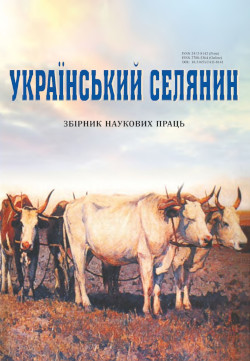The role of women in mass peasant protests under total collectivisation and the Holodomor in Ukraine
Main Article Content
Abstract
Abstract. The purpose of the article is to study the role of women in mass peasant protests during the period of total
collectivization and the Holodomor in Ukraine.
The scientific novelty of the research results lies in the highlighting of the causes, scale, features and consequences of
mass women’s peasant protests during total collectivization and the Holodomor, and the repressive measures applied to their
participants.
Conclusion. Mass women’s protests were the main form of active peasant resistance during the period of total
collectivization and the Holodomor in Ukraine. Mass peasant women’s protests of 1928–1932 against dekulakization,
collectivization, and grain procurement were called riots, rebels, «women’s riots» and «volinka» in documents of the OGPU,
the GPU of the Ukrainian SSR, judicial bodies, party and Soviet documents. The authorities explained the active participation
of peasant women in the «volinka» by «kulak influence», ignorance, women’s conservatism, the patriarchal nature of peasant
society, «certain distortions of party policy» during collectivization and dekulakization, and the «excessively lenient attitude of
the punitive authorities» towards participants in mass protests. In fact, the women’s protest was a reaction to the implementation
of Stalin’s destructive agrarian policy, which threatened not only the well-being but also the very existence of peasant families,
as evidenced by the events of 1932–1933.
«Volinka» took place in the form of demonstrations, meetings, general peasant resistance to government officials and
local activists, and collective attacks on state and collective farm facilities. The number of participants in «volinka» ranged
from 50–60 to 1000–2000 people. «Volinka» could last from several hours, a day, to several days. Women’s protests were
characterized by organization, persistence of resistance to local authorities. During «volinka» peasant women were often
armed with pitchforks, stakes, and knives. Women’s protests were accompanied by physical violence against collective farm,
party and Soviet leadership, police officers, activists, and collective farmers, and the destruction of village councils, collective
farm boards, and other institutions.
Each specific «volinka» did not pose any real threat to the regime of that time. The scale of the peasant protests was
dangerous, because in the first months of 1930 (January–March) the «volinka» covered most of the villages of Ukraine. The
serious attitude of the authorities towards mass women’s protests is evidenced by the fact that armed detachments of the GPU
and the police were used to suppress the largest and longest ones
Article Details
References
Berelovich, A. & Danilov, V. (Ed.). (2003). Sovetskaya derevnya glazami VChK-OGPU-NKVD. 1918–
[Soviet village through the eyes of the Cheka-OGPU-NKVD. 1918–1939]. Moskva: Rossijskaya politicheskaya
e’nciklopediya (ROSSPE’N), Vol. 3: 1930–1934; B. 1: 1930–1931. [in Russian].
Berelovich, A. & Danilov, V. (Ed.). (2005). Sovetskaya derevnya glazami VChK-OGPU-NKVD. 1918–
[Soviet village through the eyes of the Cheka-OGPU-NKVD. 1918–1939]. Moskva: Rossijskaya politicheskaya
e’nciklopediya (ROSSPE’N), Vol. 3: 1930–1934; B. 2: 1932–1934. [in Russian].
Borodin, Ye., Kasianov, O. & Kystruska N. (Comps.). (2008). Rozkurkulennia, kolektyvizatsiia, Holodomor
na Dnipropetrovshchyni (1929–1933 roky). [Dekulakization, collectivization, Holodomor in the Dnipropetrovsk
region (1929–1933)]. Dnipropetrovsk: Gerda. [In Ukrainian].
Danilov, V. & Ivnickij, N. (Ed.). (1989). Dokumenty svidetel’stvuyut: iz istorii derevni nakanune i v xode
kollektivizacii, 1927–1932 gg. [Documents testify: from the history of the village on the eve of and during collectivization,
–1932]. Moskva: Politizdat. [in Russian].
Danilov, V., Manning, R. & Violy, L. (Ed.). (2000). Tragediya sovetskoj derevni. Kollektivizaciya i raskulachivanie.
–1939. [The tragedy of the Soviet village. Collectivization and dekulakization. 1927–1939].
Moskva: Rossijskaya politicheskaya e’nciklopediya (ROSSPE’N), Vol. 2. [in Russian].
Kalinkina, S., Kornovenko, S., Markova, S. & Romanets N. (2017). «Velykyi perelom» na seli. Final
selianskoi revoliutsii (1929–1933 rr.). [«The Great Break» in the Village. The Finale of the Peasant Revolution
(1929–1933)]. Cherkasy: Cherkaskyi natsionalnyi universytet im. B. Khmelnytskoho. [in Ukrainian].
Konkvest, R. (1993). Zhnyva skorboty: Radianska kolektyvizatsiia i holodmor. [Harvest of Sorrow: Soviet
Collectivization and the Famine]. Kyiv: Lybid. [in Ukrainian].
Kovalenko, O., Podkur, R., Vasyl’iev, V. & Lysenko, O. (Comps.). (2012). Nastroi ta povedinka naselennia
Chernihivschyny v umovakh stalins’koi revoliutsii «zghory». 1928–1938. [Moods and behavior of the population
of Chernihiv region in the conditions of Stalin’s revolution «from above». 1928–1938]. Chernihiv: Vydavets’
Lozovyj V. M. [In Ukrainian].
Muzychenko, M. (1932). Borotba z vykryvlenniamy polityky partii shchodo rozvytku kolhospnoho
tvarynnytstva i sud. [The fight against distortions of the party’s policy regarding the development of collective
farm livestock farming and the court]. Revoliutsiine pravo. [Revolutionary Law], 11–12, 327–331. [In Ukrainian].
Sapytska, O. (2006). Uchast zhinok v selianskomu opori kolektyvizatsii ta radianskii vladi (1928–1932
rr.). [Participation of women in peasant resistance to collectivization and Soviet power (1928–1932)]. Hileia. [Gileya],
, 84–94 [in Ukrainian].
Stalin, I. (1951). Rech’ na Pervom vsesoyuznom s»ezde kolxoznikov-udarnikov 19 fevralya 1933 g.
Sochineniya: v 18 t. [Speech at the First All-Union Congress of Collective Farm Shock Workers, February 19,
Works: in 18 volumes]. Moskva: Gosudarstvennoe izdatel’stvo politicheskoj literatury, Vol. 13. [in Russian].
Vasyl’iev, V. (1997). Persha khvylia sutsilnoi kolektyvizatsii i ukrainske selianstvo. [The first wave of
complete collectivization and the Ukrainian peasantry]. In Vasyliev, V., Viola, L. (Сomps.). Kolektyvizatsiia i
selianskyi opir na Ukraini (lystopad 1929 — berezen 1930 rr.) [Collectivization and peasant resistance in Ukraine
(November 1929 — March 1930)]. Vinnytsia: LOHOS. [in Ukrainian].
Vasyliev, V. & Viola, L. (Сomps.). (1997). Kolektyvizatsiia i selianskyi opir na Ukraini (lystopad 1929 —
berezen 1930 rr.) [Collectivization and peasant resistance in Ukraine (November 1929 — March 1930)]. Vinnytsia:
LOHOS. [in Ukrainian].
Viola, L. (2010). Krest’yanskij bunt v e’poxu Stalina: Kollektivizaciya i kul’tura krest’yanskogo soprotivleniya.
[Peasant Revolt in the Stalin Era: Collectivization and the Culture of Peasant Resistance]. Moskva: Rossijskaya
politicheskaya e’nciklopediya (ROSSPE’N); Fond Pervogo Prezidenta Rossii B. N. El’cina. [in Russian].

